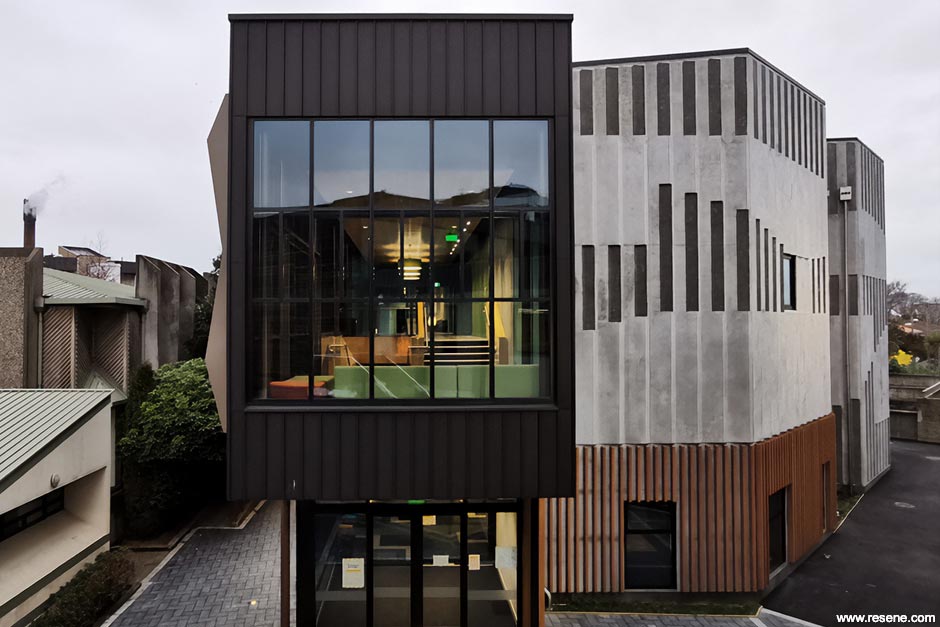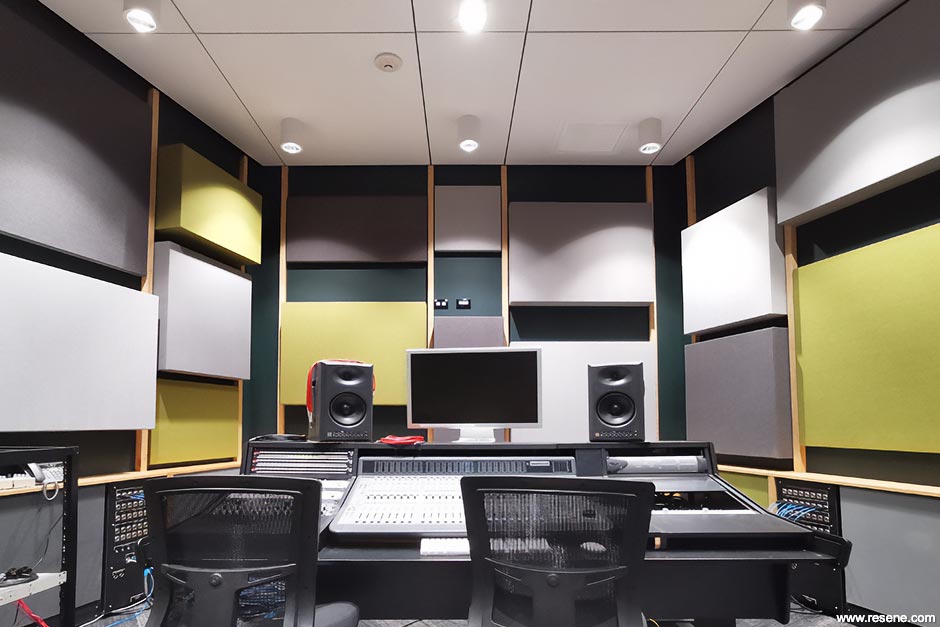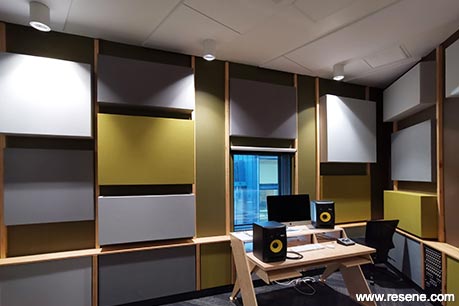Each studio space has a distinct colour scheme based on the feathers of individual native birds.
Located on the Dunedin Campus adjacent to the existing Music Suite, a new two storey extension for University of Otago has recently been completed.

Integrating the existing refurbished building, the new addition features purpose-built recording, percussion, teaching and practice rooms with a full-scale live studio and control room for recording and presentation of a wide variety of live performances with audiences up to 100 people. New collaborative spaces create opportunities for sharing expertise and facilities across the department. Its public face encourages connection with the wider community and an opportunity to showcase student work within a learning environment.


Externally, the building features a natural material palette of concrete, dark zinc and aluminium and timbers with columns and fins in warmer shades. From the interior glazed public face, the materiality is continued while bursts of green, turquoise and orange reveal a glimpse of a vibrant interior.
At ground level the new entrance to the wider school of Performing Arts, Music and Theatre, welcomes students and visitors into a public foyer along the north face which leads to practice and performance spaces to the south, facing the river and the existing music suite building to the east.

Each performance and practice space features customised acoustic panelling which offers a vibrant play of pattern and colour, complementing the creative and varied music activity featured within.
Designed by CCM Architects, the building features colour themes developed by local artist Simon Kaan through consultation with local iwi Ngāi Tahu. Together, a narrative of birdsong was developed for the building interior. Location distance between CCM Architects in Wellington and the site in Dunedin relied on a close working relationship with Architects Baker Garden and artist Simon Kaan to ensure concept themes were correctly interpreted and applied to the different spaces in the building.

Colour draws in building users from the flooring based on traditional tukutuku patterning which slowly disperses to a dark grey hue and provides the base for vibrant wall colours to draw the eye toward the teaching and practice spaces. Complementing the exposed natural wood tones and concrete, the colour scheme seeks to nurture a fresh, warm and lively sunlit public space. Selected colours are then continued into the renovated existing building to tie the designs together.
Each studio space has a distinct colour scheme based on the feathers of individual native birds. The darker hues of performance spaces, with greens and browns of the bird and its surroundings, focus occupant's attention to the performance activity. Paint colour interplays with fabric selections and natural timber detail to complete the theme for each individual space.


Resene Clockwork Orange, Resene Dell and Resene Patina feature in the main circulation zone. Branching off into the bird zones, Kereru is resplendent in Resene Racing Green, Piwakawaka features Resene Deep Bronze and Resene West Coast, Toroa is finished in Resene Triple Concrete and Tui in Resene Stingray and Resene Racing Green.
The green room is soothing in Resene Quarter Periglacial Blue. The softer palette continues to the back of house with Resene Eighth Truffle and toilets in Resene Sisal, while more grounding hues of Resene Lemon Grass, Resene Sepia and Resene Element on the doors and frames.
Externally, the building evokes the undulation of music through the patternation on reinforced concrete panels and the changing wave form of the shading screens. The natural cool colours of concrete and dark zinc are complimented by warm browns in the timber, shading fins and colonnade to foster a sense of welcome to the public facing façade.
The building was under construction while the final design for the colour scheme was being developed and agreed with the artist and client. Colours schemes and materials needed to fit within strict budget constraints but also needed to meet the high performance requirements for this bespoke building typology and be available on site as soon as possible. The project contingency was all but used up following foundation work so there was no room for cost movement and programme timings meant some individual long lead time selections were needed prior to the full colour scheme having been agreed.
Nearly every wall colour is different! Spaces needed to be fully elevated to define the colour and relationship to other elements and surfaces and then checked on site to make sure it worked.
Inside Resene SpaceCote Low Sheen was selected to bring a tough finish to wall areas while minimising the reflectivity of the wall and minimising glare. Ceilings were finished in matt Resene Ceiling Paint in Resene Alabaster. For high impact areas such as doors and frames, Resene Lusta-Glo semi-gloss was chosen for its hardwearing finish.
Exterior fibre cement sheet clad areas and soffits were finished in Resene Sonyx 101 semi-gloss waterborne paint for a durable and easy to maintain exterior finish with Resene Alabaster on soffits, Resene Element on exterior back of house and Resene Triple Concrete on roof plant. On the exposed concrete exterior panelling, a graffiti coating was needed at the lower level with general protection to the entire face. To achieve a low sheen finish, Resene Aquapel, Resene Concrete Clear and Resene Uracryl GraffitiShield Low Sheen were used.
The exterior and interior public colonnade along the length of the building sought to match the warmth of the other screening elements but with a slight shimmer. Working together with Resene, a new colour was developed for this part of the project and aptly named Otago Spark. For the feature columns, to get the right balance of robust finish and correct sparkle, Resene Armourcote 220 with Resene Imperite I.F. 503 was used.
Resene Waterborne Woodsman Limed Oak was applied to protect the exterior timber fins with its more environmentally favourable waterborne composition, enhancing and protecting the natural grain and patina of the timber as it weathers.
Architectural specifier: CCM Architects
Building contractor: Naylor Love
Client: University of Otago
Colour selection: Simon Kaan, CCM Architects
Interior designer: CCM Architects
Site architect, client liaison: Baker Garden Architects
Photographer: Baker Garden Architects
Project: Resene Total Colour Awards 2020
Resene case studies/awards project gallery
View case studies that have used Resene products including many from our Resene Total Colour Awards. We hope these projects provide inspiration for decorating projects of your own... view projects
Total Colour Award winners:
2023 |
2022 |
2021 |
2020 |
2019 |
2018 |
2017 |
2016 |
2015 |
2014 |
2013 |
2012 |
2011 |
2010 |
Entry info
Latest projects | Project archive | Resene news archive | Colour chart archive